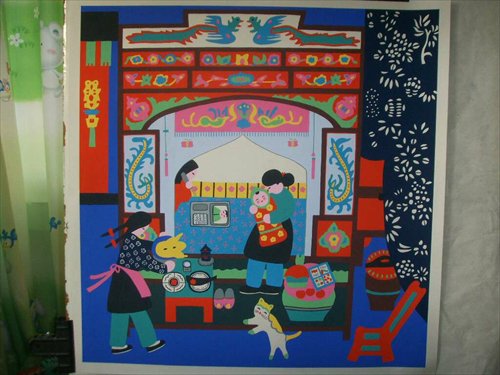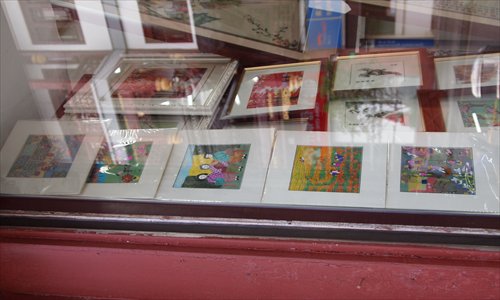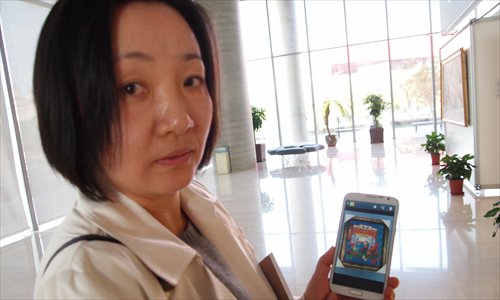HOME >> CHINA, METRO SHANGHAI
The peasant painting poser
By Ni Dandan Source:Global Times Published: 2014-11-25 18:43:01
Unique Shanghai art style threatened by fakes and low prices

A detail from Announcing Good News Photo: Courtesy of Wang Ani
In the Pudong Library in front of a vivid painting titled Utopia, Wang Ani was explaining the ideas behind the peasant painting to some Japanese artists. Wang, a Jinshan peasant painter, had two of her works on display at the 50th Asia Contemporary Art Exhibition which has been running at the library over the past few days.
Wang was there talking to the other contemporary artists from different fields and explaining the origins and style of Jinshan peasant painting to visitors.
Jinshan peasant painting began life in the 1970s and in 2007 was listed an intangible cultural heritage by the city government. Jinshan district is in the southwest of Shanghai and many of its peasant painters now live in the picturesque ancient water town, Fengjing.
The paintings of the Jinshan peasant style usually depict beautiful idyllic scenes, lively rural life and joyous festivals, all portrayed in bright simple colors, similar to the naïve style of art popular in the West.
As one of the painters of this unique style, Wang was chosen to demonstrate her painting style to a delegation led by China's First Lady, Peng Liyuan, during the Conference on Interaction and Confidence Building Measures in Asia in May. In her early 40s, the woman is one of the most prominent Jinshan peasant painters, exhibiting in numerous galleries and at competitions.
She told the Global Times that while the Jinshan painters of her age knew how to deal with young people and how to use computers, the older generation of artists had problems. "The painters in their 50s and 60s rarely come out, let alone socialize."
Not easy
For these artists, connections and contacts are vital - most make their living from the sale of their paintings. Although the local authorities have promoted the artists in their Fengjing town village as an important tourist destination, it is not easy making money from art.
And what is now making it even harder is the spread of fake peasant art. Fake Jinshan peasant paintings reportedly began to appear 10 years ago but the painters had hardly any recourse then, said Xi Jiping, the president of the Shanghai Jinshan Peasant Painting Academy.
"We did win some court cases over fake paintings but the proceedings were so costly that though the artists won their cases they lost money. The costs of protecting copyright are too high for rural painters," he told the Global Times.
However Wang Ani was involved in a legal case earlier this year which she hopes might help change the way artists can use the law to protect their work.
Wang was stunned when she found one of her paintings, Announcing Good News, had been reproduced as a candy wrapper. The painting, which was done some years, before, shows a new mother video-phoning her relatives abroad to tell them of the birth. It was a good work and picked up third prize in an art competition.
But a while ago culture inspectors in Jinshan district found an online candy shop selling a brand of candy wrapped in a reproduction of Wang's painting. The moment she heard of this she contacted the shop.
"The design of the candy wrap is 98 percent the same as my painting. But when I told them that they had stolen my intellectual property, they didn't take it seriously and just offered me 1,000 yuan ($162.80) to solve the matter," Wang said.
Wang felt degraded. This, she felt, was about respect for the work of an artist. Luckily for her the painting had been registered with the Shanghai Copyright Administration. The Shanghai Jinshan Peasant Painting Academy, on behalf of Wang, filed a complaint against this shop through the online shopping mall's intellectual property rights section.

Fake Jinshan peasant paintings on display in a shop in Shanghai's City God Temple Photo: Ni Dandan/GT
Settlement agreed
Confronted with hard evidence in the form of the copyright registration, the shop admitted copying Wang's painting and eventually paid the artist 8,000 yuan for the right to use the work as their candy wrapper for two years.
"This was the first time I have taken action to protect my intellectual property rights but it's not the first time my paintings have been copied. I saw some rough copies of my paintings for sale in a stall at the City God Temple. I didn't say a word there - I knew confronting the vendor would end up in nothing."
Stalls around the City God Temple are reportedly where the fake Jinshan peasant paintings flourish. At one of these stalls a middle-aged Shanghai vendor insisted his paintings were authentic and made by recognized peasant painters in Jinshan.
He was asking 50 yuan for 15-centimeter square paintings but could not explain to the Global Times why none of the works had signatures or official seals.
Cao Xiuwen is in her late 50s and has been a peasant painter in Jinshan for 40 years. She is one of the four officially recognized heirs of this intangible cultural heritage. She said almost all the experienced painters sign their works.
"Many of us older artists prefer to do larger paintings these days. One obvious reason is that our eyesight isn't good enough now to do these small paintings. But at the City God Temple they sell small pieces because buyers like those more." She said, because of the simplistic style of their works, peasant paintings were relatively easy to copy.
It's not just in Shanghai that fake paintings are found. One of the other nominated heirs of the painting style, Huai Mingfu, said he had seen copies of his prizewinning works sold in street stalls in Shaanxi and Yunnan provinces. "I didn't know what to say. Collecting evidence is difficult. Protecting our intellectual rights is easier said than done," he told the Global Times.
At the 2010 World Expo in Shanghai, Huai's painting Festive Drums was showcased but the 1.3-meter-long painting was soon for sale online, and in whatever size you fancied.
When he discovered his work was being copied and sold online Huai was very angry but didn't bother taking legal action. "If I had I would have had to hire a lawyer, collect evidence, file my case with the court and this would take at least six months before there would be a judgment. It's too time-consuming. And eventually I would only get a few hundred or thousand yuan in compensation. I couldn't afford the time and energy for this."
Legal protection
Wang Ani's case however was solved and over in a little more than a month - thanks to the academy's copyright registration system. Xi Jiping said that the academy started to work with the city's copyright administration two years ago, helping organize the peasant painters have their works registered. "This way these paintings can be protected in law."
Xi told the Global Times that to date 73 paintings by 17 painters had been registered with the copyright administration. Because this is a special issue to protect the Jinshan art, one of the city's cultural attractions, Xi said the copyright administration wasn't charging anything for the registrations which normally would be worth a few hundred yuan.
"Many of our painters are not wealthy and registration is free for them but we have to limit the number that we can register. The artists have to choose some of their typical or classic works," Xi said.
Alongside the registrations the academy is coaching the peasant artists in their intellectual property rights and how they can protect these. Xi would like to see the public more aware of the problems so that people would stop buying fake or copied paintings.
There are only a few places where genuine Jinshan peasant paintings can be bought. "We have an outlet in the Okura Garden Hotel. Potential buyers can also contact the academy or the painters themselves and can visit the painters' village, where the paintings are generally authentic."
Although Jinshan peasant paintings don't have a distinctive hallmark, Xi said most buyers would be able to tell the genuine article from a fake by the price. "Usually a 60-centimeter painting takes 10 to 15 days to complete from the artist creating a theme, then drawing the outline, choosing the colors and completing it. The time alone means that paintings this size will never be sold for 100 yuan or less."
Cao Xiuwen said she normally charged 1,200 yuan for a painting this size although a Jinshan peasant painting of this size has been auctioned for 38,000 yuan.

Wang Ani shows her painting Announcing Good News on her mobile phone. Photo: Ni Dandan/GT
Issue of survival
The fake peasant paintings that are freely available in markets and on the Internet for much lower prices are a real threat to some of the older painters who don't get out a lot or use computers. Cao Xiuwen told the Global Times that she didn't dare charge more than the market average because she would have no income at all.
For a 15-centimeter painting Cao now charges 60 yuan, exactly the same price as a City God Temple fake. "I get 40 yuan for a painting of this size but it takes me seven or eight hours to do this. I know I am officially an heir to this painting style but I don't feel like an heir."
Cao turns 60 next year when she will be eligible for a government pension which is 600 yuan a month. "I'd like to spend all my time promoting the painting style. I love teaching children and young people how to paint this way but reality and having to earn my living prevents me from doing this."
Never paid
Although the city government named her as one of the few heirs to the intangible cultural heritage, Cao said she has never received any steady promotional work or a single penny of subsidy from the government. She has to make her living by painting. "To paint a work for the academy I need to spend more than 10 days and they pay me 500 yuan. The price was set 10 years ago and has never been increased."
Last year Cao made 150,000 yuan but this year business has not been so good and she expects her annual income will be about 70,000 yuan. "People used to buy my paintings as gifts but the anti-corruption campaign has discouraged a lot of gift buyers."
She thinks the future of Jinshan peasant painting is being seriously threatened by the financial constrictions - no one would want to take this up if you can't make a living from it. She said some children in Jinshan had been interested but when they came of working age none of them wanted to do it full time.
In Jinshan these days there are more than 1,000 peasant painters but Huai Mingfu said only 20 of these were producing quality works.
Newspaper headline: Unique Shanghai art style threatened by fakes and low prices
Posted in: Society, Metro Shanghai, City Panorama